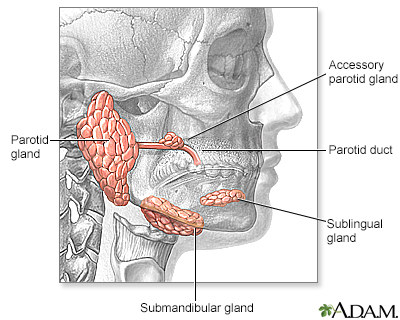Pregnancy SmartSiteTM
Parotitis; Sialadenitis DefinitionSalivary gland infections affect the glands that produce spit (saliva). The infection may be due to bacteria or viruses. There are 3 pairs of major salivary glands:
All of the salivary glands empty saliva into the mouth. The saliva enters the mouth through ducts that open into the mouth in different places. CausesSalivary gland infections are somewhat common, and they can return in some people. Viral infections, such as mumps, often affect the salivary glands. (Mumps most often involves the parotid salivary gland). There are fewer cases today because of the widespread use of the MMR vaccine. Bacterial infections are most often the result of a:
SymptomsSymptoms include:
Exams and TestsYour health care provider or dentist will do an exam to look for enlarged glands. You may also have pus that drains into the mouth. The gland is often painful. A CT scan, MRI scan, or ultrasound may be done if the provider suspects an abscess, or to look for stones. Your provider may suggest a mumps blood test if multiple glands are involved. A bacterial culture can help identify the organism causing the problem. TreatmentIn some cases, no treatment is needed. Treatment from your provider may include:
Self-care steps you can take at home to help with recovery include:
Outlook (Prognosis)Most salivary gland infections go away on their own or are cured with treatment. Some infections will return. Complications are not common. Possible ComplicationsComplications may include:
When to Contact a Medical ProfessionalContact your provider if you have:
Get medical help right away if you have:
PreventionIn many cases, salivary gland infections can't be prevented. Good oral hygiene may prevent some cases of bacterial infection. ReferencesElluru RG. Physiology of the salivary glands. In: Flint PW, Francis HW, Haughey BH, et al, eds. Cummings Otolaryngology: Head and Neck Surgery. 7th ed. Philadelphia, PA: Elsevier; 2021:chap 81. Jackson NM, Mitchell JL, Walvekar RR. Inflammatory disorders of the salivary glands. In: Flint PW, Francis HW, Haughey BH, et al, eds. Cummings Otolaryngology: Head and Neck Surgery. 7th ed. Philadelphia, PA: Elsevier; 2021:chap 83. | |
| |
Review Date: 9/10/2023 Reviewed By: Josef Shargorodsky, MD, MPH, Johns Hopkins University School of Medicine, Baltimore, MD. Also reviewed by David C. Dugdale, MD, Medical Director, Brenda Conaway, Editorial Director, and the A.D.A.M. Editorial team. The information provided herein should not be used during any medical emergency or for the diagnosis or treatment of any medical condition. A licensed medical professional should be consulted for diagnosis and treatment of any and all medical conditions. Links to other sites are provided for information only -- they do not constitute endorsements of those other sites. No warranty of any kind, either expressed or implied, is made as to the accuracy, reliability, timeliness, or correctness of any translations made by a third-party service of the information provided herein into any other language. © 1997- A.D.A.M., a business unit of Ebix, Inc. Any duplication or distribution of the information contained herein is strictly prohibited. | |

 Head and neck glan...
Head and neck glan...
